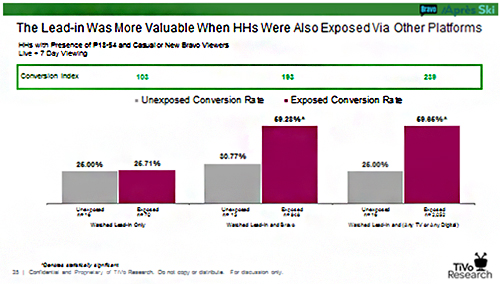by Bill Harvey, Chairman & Co-Founder, Research Measurement Technologies

Abstract
Conversion is an ROI metric and is already being programmatically optimized by best of breed digital players1. ARF Ground Truth Squared is aiming at the creation of norms by which media planning can optimize ROI2. Because of the number of variables involved in optimizing ROI, a fast, inexpensive new form of AB testing has been developed which can in time become programmatic, that in conjunction with singlesource can accelerate the collection of norms at scale. Each brand will gain from determining its own norms and updating them for each new creative execution, as the cost of such science is far less than its economic benefits.
I. Background
1962 was the year that media optimization began in the U.S., led by Y&R with Bill Moran’s High Assay Media Model (HAMM) and Benton & Bowles with their Linear Programming (LP) Model3. Starting with direct mail, direct marketers at about the same time began to experiment with automated systems that would enable optimization, with a difference: brand marketers for the last half century continued to optimize against the reach of a target, typically a demographic group. Direct marketers have always sought to optimize against ROI. In wasn’t until a few years ago that the industry became able to realize that reach of a demographic target has very little impact on ROI4. This fact remains little known. 99% of all brand TV buys continue to be made based on sex/age guarantees or expectations.
With the widespread adoption of Marketing Mix Modeling beginning5 in the 1980s following the introduction of supermarket scanners, it was only a matter of time before users began to construct simulators and optimizers by which an automated tool could find the best allocation of budget to marketing channels. One of the first of these was in a GroupM dashboard system called LIVE which was demonstrated to the author in the mid-00s.
However, MMM optimization is very broad. For example, it says how much of the budget to put in TV. But that leaves a lot out in terms of being able to optimize where in TV and in what kinds of TV the money should be invested. The devil is down at this tactical level. We have already seen that the pandemic practice of sex/age targeting neuters ROI, regardless of how good an MMM optimizer you might have. You put the right percent of the budget in TV, but then squandered all that money away. Little reason to be surprised then at the low growth of the economy.
Being able to optimize ROI at the tactical level was always what separated direct marketing from brand marketing, until the mid and late 00’s when Apollo and TRA were introduced. The data collected by these two types of sustainable singlesource6 systems offered for the first time the possibility that some day in the future such data could be made to operate within an ROI optimizer for brand advertising. Today the leading edge practitioners are not quite there yet, thinking more in terms of what-if planning systems. However, RMT is unlikely to be the only one developing a non-MMM-based ROI optimizer that is instead based on household level and zipcode level data.
II. Objectives
We set out here to lay down some of the basic requirements of ROI optimization, the complications they bring, and how these can be solved. We will seek to establish that the least work has been done in the highest impact area, namely the creative, and its interaction with the environment and the individual. Not only does the creative have more power, as we shall see below, than media; but the complex interaction effects among individual psychographics, media psychographics, and ad psychographics is far more complicated and challenging than the physical choices of environments in which to place ads. All of which must together be optimized.
III. Ground Truth
Based upon extensive global MMM meta-analyses and new laboratory studies, in March 2016 ARF published its conclusions from the first stage in this epochal journey, indicating that:
- Media synergy is a more powerful factor than previously realized, and all of the new and traditional media should potentially be included in an ROI-optimal plan
- This should be done without reducing the TV budget, because its ROI is highest
- Underlying creative messaging should be integrated across all media
- The creative needs adaptation to bring out its greatest strength in each medium
TiVo Research was simultaneously finding out the same things. A study7 presented at the same ARF Re:THINK 2016 conference sponsored by Turner and A&E supported the ARF’s second point by showing that of 15 brands who cut TV, 11 went down in sales, averaging $3 in sales losses for every $1 of TV saving.
It’s known that there have already been widespread shifts from TV to new media, so the ARF’s findings inevitably suggest that advertisers consider returning some of those dollars to TV, which some have already begun to do.8
ARF has compiled a list in connection with Ground Truth of the “redefined television” options that would be worth considering as advertisers rethink their TV investments. Conversations are overheard in which the idea of establishing an optimal percentage for these advanced TV options. The figure of 15% is mentioned. Not as a box to check, but as a way of estimating the number of studies needed to create tactical ROI optimization, let’s start with that list of media:
Redefined Television
-
- Purchaser targeting by matching
- Context Resonance weighting
- Interactive TV
- Addressable TV
- Native including OTT
- Integrated Marketing
- Digital Video – Mobile
- Digital Video – Desktop
- Smart TV
- Second Screen
- Programmatic
Imagine that list is a subset of all the tactical media options one ought consider. Media is one of four categories which together determine brand marketing ROI. The four are:
MEDIA
CREATIVE
PRODUCT
INDIVIDUAL
In a future ROI tactical planning system, the artificial intelligence (AI) would start with a fourth dimensional lookup table in which each side of the hypercube would be one of these variables. The AI would decide which subtype this new campaign was, in each of the four dimensions, and this would determine a cell in the hypertable in which were locked all the secrets of how to win under these circumstances, in this combination of the four driving forces.
Media is obviously all of the different types of media and creative is obviously the unique ad that has never existed before and will never exist again exactly the same. We already know that different products have different frequency requirements, for example, and that there are low-involvement vs. high-involvement products whose advertising requirements are quite different. ARF Ground Truth has already shown for example higher ROI lifts when various digital media are added to TV for products in which search for information is most common.
What about the individual then? This is probably the most complicated piece of the equation. Albeit it is not as useful for ROI, demographics have served the industry well, as have geographics, as means of gaining more insight into marketing phenomena. Geographics interestingly turn out to be more relevant to ROI than demographics, as we shall see.
However both geographics and demographics fail to describe what we experience when we meet one of these human beings. So much is left out by reading a demographic and geographic description of a living person. That gap is what is meant by the term psychographics.
IV. Psychographics
In 1972, Dr. Timothy Joyce and I began collaboration on the development of a holistic psychographic system. We were frustrated by the profusion of psychographic systems people were creating for use in advertising planning. I had just come from BRI where I’d helped develop a psychographic system based on product benefit segmentation. VALS had an excellent system. We wanted a system of systems, one to include all.
Analysts went through the Oxford Unabridged Dictionary, pulling out over 13,000 words that could be used to describe an individual’s traits or states. National probability samples enabled respondents to scale themselves on these traits and states and factor analysis reduced the number to 1562. Timothy extracted the top 20 explaining the most variance and made them a scale that was used in TGI and then in MRI. Today that 1562 has been reduced to 265 by my company Next Century Media using set top box data by excluding words that have no significant correlation with program choice behavior. The 265 DriverTags explain 76% of the variance in Nielsen ratings10.
It is our thought that, while probably imperfect and even better science can develop from this, at the moment DriverTags hold one of the needed keys to crossmedia tactical ROI optimization. Why? Because:
-
- The same DriverTags can be used to describe nuanced attributes of all four forces (MEDIA, CREATIVE, PRODUCT, and INDIVIDUAL) in a programmatic ROI optimizer; enabling matching of ads into contexts and addressed to individuals not only based on purchase propensities and all other considerations, but also based upon the creative communication to individuals which lies at the heart of the advertising and marketing process.
- DriverTags are highly predictive of one type of behavior that is very important to the marketing process (TV viewing).
- “Brands that become highly liked by users help those users become something they want to become. And programs and movies whose characters represent something the viewer wants to become, are the ones that those people watch.” These are the hypotheses of Dr. Americus Reed at Wharton11, an Advisor to RMT. So all of these four factors (MEDIA, CREATIVE, PRODUCT, and INDIVIDUAL) are inextricably wrapped around each other already based upon the deepest subconscious and conscious motivations in the individuals, their values and aspirations.
To simplify and summarize, use of psychological tags is the practical solution to reducing the complexity of ROI optimization. There will still be many media options to consider and a wealth of other variables, but at least we will have a handle – the same handle – on the individual and the creative, as well as the program context and the product image. This reduces a chaotic problem to a manageable one.
V. Operationalizable Optimization Variables
The four supercategories we have been discussing break down into a small mountain of “tune-able” operational variables which need to be included in marketing ROI optimization in order to be complete and leave out as few variables as practical which could change the solution. Here are the Top 20 operational variables regarding the stimuli:
-
- Size of budget
- Media costs
- Competition creative and media tactics
- Creative foundation
- Creative execution
- Media synergy
- Purchaser target
- In-store/promotion/price
- Branded integration/true sponsorship/branded content/cause marketing
- Geographic dose-response
- Media context effects
- Psychographic alignment of CREATIVE, MEDIA, INDIVIDUAL and PRODUCT
- Timing
- Fast Reach
- Recency/frequency distribution/continuity/days of week when shopping
- Interactivity
- Versioning
- Sequence effects
- Sex/age target
- Blacklisted media options
The operational response variables include both short term and longterm effects such as:
-
- ROI/ROAS (maximized) /cost per conversion (minimized)
- Store/showroom traffic
- Website visits
- Search for brand
- Brand liking/brand is my friend/involvement (more than satisfaction/loyalty12)
- Net Promoter Effect
- Brand Equity
Unlike reach optimization, which is generally done with a single system, ROI optimization calls for an “ROI REGIME” approach using multiple systems in a specific sequence. At a high level, a brand should first conduct looking-backward singlesource. This is epidemiological research and as such the patterns which one observes reflect correlations not necessarily causation and therefore might not replicate going forward. A second step after singlesource is to do small-geo AB testing to go beyond correlation and determine the actual causality based on controlled experimentation where only a single variable is the difference between A and B. The cycle needs to be repeated every time there is new creative. Even when the creative has not yet changed but new media options are being considered, small-geo AB testing is the way to make such decisions at the lowest cost and the greatest chance of ROI increase.
VI. Size of Budget
Optimization over the past half century has tended to stay away from including the size of the overall investment, although that is arguably the most important factor. The most accurate way to understand the effect of increased spend is to do heavyup tests. The industry has greatly reduced its use of such in-market testing (except for direct response) due to the slowness and cost of such testing. However, the speed and cost factors become positive when one tests below the level of whole markets, as in cable zone and zip AB testing.
VII. Creative
Creative is 65% of ROI and media is the other 35%13, according not only to TiVo Research but also Mars Catalyst, and Apollo14. comScore comes up with a very similar finding (80% creative) if one repercentages within the explained variance in the following slide:
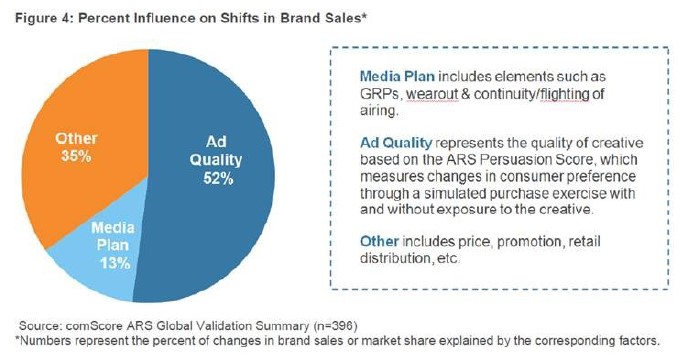
The creative foundation that will tend to be the most successful for a brand will be one that:
-
- Speaks to the aspirations of the targeted users
- Reflects the realistic experience the trier will get from the brand
- Does not run aground on frozen perceptions of the brand
- Is inspiring to the manufacturer’s employees as a raison d’etre
- Is not a me-too of competing brands
Creative execution will tend to be most successful when:
-
- There is consistency with the brand’s established positive imagery
- Messaging style reflects the mores of the target
- The principles of creative foundation (above 1-5) are exemplified
Not only can we not leave out creative, as optimization has always done in media optimization, it is one of the weightiest factors in driving ROI and all the other desired outcomes.
If one has optimized all variables and a new creative comes along, it brings in a vast amount of variance that has yet to be optimized, not only because it changes the creative variable, it also changes the covariance with individuals, media, and the product image. Being new creative it will not find immediate guidance in historical singlesource data, and therefore the only fast way to reoptimize requires small-geo AB testing.
VIII. Media synergy
ARF Ground Truth found that, on average, a second medium adds 19% to ROI, a third medium 23%, a fourth medium 31%, and a fifth medium 35%15. TiVo Research and 84.51 found that there is a large (equal to 40% of the TV sales effect alone) synergy effect between in-store and television16.
The profound importance of synergy is clearly demonstrated in two TiVo Research studies17 of tune-in advertising in which certain media types had almost zero rating lift impact when the household received only that type; but in combination with another type, added significantly to that type’s ability to raise ratings. Paid TV advertising, paid local TV advertising, and the lead-in all appeared to have little or no impact in the two studies unless combined with other unpaid and digital, whereupon they lifted the ratings increases of the latter media by double or triple digits. One example:
IX. Purchaser Target
Studies by TiVo Research show that as the campaign impressions skew to purchaser targets, the ROI increases. The relationship is 0.7 ROI percentage points increase for every 1.0 percentage point increase in the density of the purchaser target18.
Because of this strong relationship, as a pragmatic first interim step toward ROI optimization, practitioners can use a reach optimizer against a purchaser target as a first order approximation of an ROI optimizer solution.
Note that not all purchaser targets are equally effective at raising ROI. The best purchaser targets are those which have been determined by the brand to be currently the ones driving the business growth. The selection of the best purchaser target must be made based not only on the sales responsiveness of the purchaser target, but also based on its volumetric size within the brand’s business. Multiple purchaser targets can be weighted together. The best purchaser targets tend to reflect three things: the category purchase heaviness, prior experience with the brand being advertised, and headroom (the brand is not already being bought as heavily as realistic by the household). Thus Heavy Swing Purchasers (HSPs), a TiVo Research term, are category heavies who buy the advertised brand but not loyally, and this target has been found to be the growth driver of most mature CPG brands by TiVo Research, work now being generally replicated by Nielsen Catalina in the matrix of HML category vs. HML brand Share Of Requirements.
X. True Sponsorship
There is a Gratitude Effect when Branded Integration/True Sponsorship/Branded Content/Cause Marketing are used properly and executed with virtuosity.19 These are high impact deviations from straight “sell” advertising which are not screened out as ads and therefore break through clutter. Representing a very small percentage of total advertising investments today, they were virtually all of advertising on early television, when “cans went flying off shelves”. The likelihood is that these forms will expand even more rapidly when tactical ROI optimization becomes a reality.
XI. Geographic Dose-Response
There are variations in a brand’s sales responsiveness across all U.S. zipcodes that are not well predicted by the age-old practice of considering CDI (category development index) and BDI (brand development index) to be positive indicators of where to place media. RMT has identified 8 other variables which combine with derivatives of CDI/BDI as a better predictor of sales responsiveness. By shifting a percentage of media from national to heavy up these local areas of opportunity, a no-growth brand can increase its national sales20. An ROI optimization regime would include the exploitation of this variable. These advanced variables should also be used in matching of AB test areas. In another implementation, AB tests conducted mostly in high sales response areas (with a subset in average areas for calibration to national projection) will tend to pay for themselves in the amount of sales increase they create, as illustrated by the hypothetical numbers in the following slide:
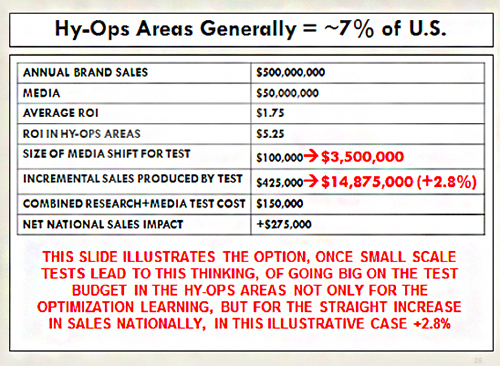
XII. Media Context Effects
There is a very large body of research proving that the effectiveness of message communication is strongly influenced by the context in which it is apprehended21. Horace Schwerin in the 1950s published information indicating that the persuasion effect of radio commercials was reduced for food and beverage products in fear producing programming, whereas the latter environment increased the persuasion effect for headache remedies and life insurance. Joel Axelrod22 and Sunir Everelles23 are two among many researchers independently reconfirming that contexts creating positive affect generally uplift advertising effects (although categories such as headache remedies and life insurance could be exceptions).
A representative recent sample of such studies is shown in the following slide in which the emotional mood of the program and ad when they are aligned creates upticks in communication measures24.
href=”https://www.rmt.solutions/wp-content/uploads/2022/12/12-4-value-of-resonance.jpg”>
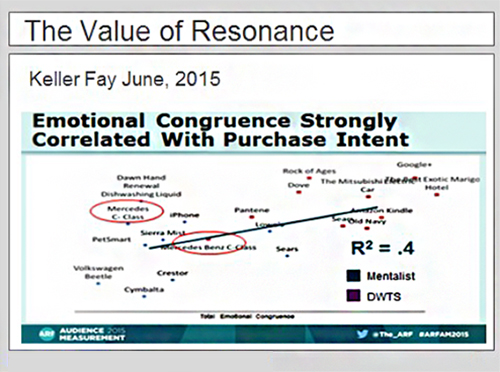
When one reviews a large number of studies of context effects the general impression received is that the uplift in efficacy metrics averages in the +20% range. Perhaps the most authoritative recent study which showed a +20% increase in longterm memory encoding was conducted by Neuro-Insight for Turner25.
The optimization of context can be achieved programmatically by the use of tags on ad and program content. To the degree that the tags have been shown to correlate highly with relevant behaviors such as content and especially product consumption, the ROI output of such a tag-based overlay on “CPM purchaser target” / “cost per purchaser target incremental reach” variables will be increased. That is why RMT recommends using its DriverTags for this purpose. The following slide illustrates the kinds of media activation specifications which come out of an ROI optimizer, in which specific commercials within a pool are fitted into different programs to maximize in this case swing voter reach weighted by the context resonance with the specific ad.
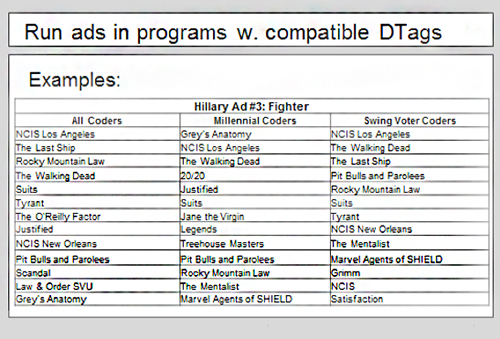
Widening the meaning of the term “context”, ROI optimization must also consider other aspects of the environment in which a message was apprehended, such as whether the individual is or is not consuming content socially. Innerscope’s study for Turner indicated that socially viewing TV increased ad communication metrics on average by +30%, even if the viewing partner was distant and connected only by electronic communication.26
XIII. Psychographic Alignment
The tag approach can also be used, especially with addressable media, to maximize the agreement between the tags on a person or household and the tags on an ad.
XIV. Fast Reach
It has now been established that faster reach build, such as produced by higher rated TV shows, covers more shopping events with recency, than a slower reach build27. This is yet another factor that needs to be properly weighted into ROI optimization.
XV. Recency
In mid-20th Century America, Wednesday was the best shopping day; today, with most family members working, Saturday has become the best shopping day for almost all products28. For CPG products, it has been widely established that advertising’s short term sales effect is most pronounced for a 48 hour period, suggesting day of week be considered within ROI optimization29. The decay curve for other product categories needs to be empirically established for ROI optimization.
XVI. Interactivity
The ability to capture a response of any kind has been shown to be dramatically useful by digital advertising. In television there are a few advertisers quietly taking advantage of adding interactivity to television advertising by various means. WiO30 for example is a phone app that makes any non-interactive medium instantly interactive. As more advertisers become aware of the advantages of setting up two way interactive communication with end users and tying this to non-interactive media to make every media type interactive, the increases in ROI will need maximization by inclusion in ROI optimizers.
XVII. Versioning
Eyeview31 and Visible World32 are two companies that offer programmatic means to send customized commercials via TV and digital. In social media, Polygraph33 offers programmatic customization. In an ideal ROI optimization platform, the tag method would be combined with versioning to maximize tag alignment on a household by household and/or person by person basis.
XVIII. Sequencing Effects
Anecdotal recent work has shown TV followed by social media to be the most effective sequencing, and other recent studies have produced the opposite conclusion, suggesting that it depends on the product, creative, target, and possibly on the specific media within TV and social media. Singlesource can be used to look back and inspect cases of different sequencing, and AB testing can be used to corroborate conclusions before major investment behind them.
XIX. Addressability
In the 1990s, the Addressable Advertising Coalition of the top 20 agencies, most networks, MVPDs, industry associations, technology companies and top advertisers, put out a paper calling for CPMs to be set for addressable TV commercials that would result in the cost per purchaser target being reduced versus average non-addressable TV34. Although 42 million U.S. homes can now receive forms of addressable TV commercials and 60 million is forecasted for the end of 201635, they are sometimes priced so as to not reduce this parameter, and therefore would not tend to be selected in ROI optimization. Education will eventually result in the optimal pricing of addressable commercials which will then tend be selected in ROI optimization. A major theme of ROI optimization will be the planning integration of addressable and non-addressable media.
XX. A Proposed Design for Inclusion in Ground Truth Squared 2016
The vast complexity described above as requirements for ROI optimization can seem daunting, yet let us not allow perfection to be the enemy of the good. Increased ROI across the industry is at hand by simply taking the first steps in the right direction. We recommend that within the total work done in 2016 by Ground Truth, a specific design be utilized to allow the rolling-up of datapoints to yield norms beneficial to the entire industry. The recommended design starting point follows.
-
- Three brands tested within each of five product supercategories: CPG, automotive, Rx, tune-in, and 1PD (advertisers who have their own first party data such as retailers, insurance companies, airlines, et al).
- Each brand conducts a singlesource study looking back at the campaign it has been running and its ROI by targets, creative, media, frequency/recency, and whichever other dimensions listed above are most important to the brand and its agency.
- The latter learning is used to inform an AB test of the most promising creative and media shifts discovered in the singlesource phase.
- For most brands, advertising is going on all the time, and so the most practical approach would be heavyup tests in which the creative/media content in the heavyup is the variable, and the key information one seeks is to find the combination of creative and media for the heavyup which produces the largest ROI increase. This is illustrated in the following slide:
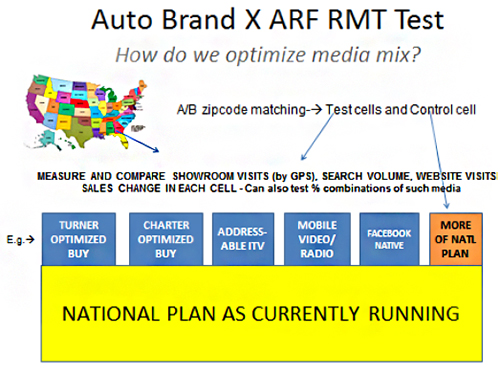
- Once verified by AB small geo testing, where a brand sees that a specific mix for heavyup yields significantly more than the cost of the heavyup, a brand would then roll out that heavyup starting in high sales response areas and continuing with sales tracking so as to stop when one has gotten so far down the list of geo areas that the heavyups are no longer paying back.
- Meta-analyses roll up insights and norms from both the singlesource and AB testing phases.
- The objective would be to understand norms for specific media mixes and sequences within each of the five product supercategories. Other norms could also be aggregated covering targeting (e.g. purchaser targeting by direct match vs. other methods) and creative variables (e.g. tag method used vs. not used).
- A secondary objective would be to maximize use of the forms of advanced TV/video advertising listed above, so as to determine whether a fixed minimum percentage in these media might be a generally applicable prescription for high ROI.
- An option for even more learning would be to also use singlesource in the AB geos themselves, so as to have household level data to analyze throughout all phases of the work. This is illustrated in the following slide:
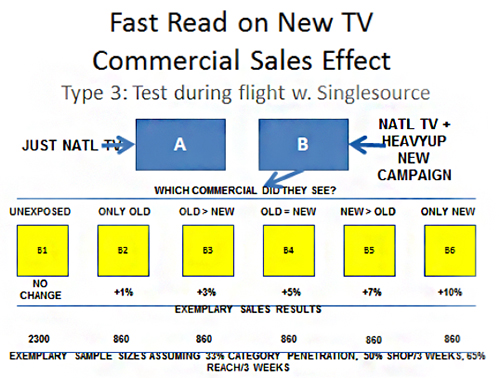
In Summary
In the long run, the ROI optimization journey will have dramatic early effects by attacking the strongest variables first, making certain of causality by means of the singlesource + AB combination. The cost of this learning can be significantly reduced, and its speed accelerated, by industry cooperation through ARF Ground Truth. The three brands in each supercategory will gain the most competitive advantage and only give up topline findings anonymously through ARF norms revelations.
References
These are but three examples, there are many more.
2 The idea of norm collection for use in media planning systems was suggested to ARF by Turner’s Howard Shimmel during conversations among leaders of Ground Truth.
3 A brief personal history of media optimization https://www.billharveyconsulting.com/articles/pdf/history-of-media-opt.pdf
4 Larguinat and Harvey, “The New Research is Bringing Transparency Between Marketing and Finance”, ARF, AMS 2011. See slide on page 8 which shows flat or negative sex/age target indices of ROI for all 8 brands, whereas all purchaser target indices of ROI are positive. Reach against purchaser targets is positively correlated with and predictive of ROI. The same is not true for sex/age targets.
5 Multiple regression analysis was invented by Udny Yule in the 1890s according to http://epd.sagepub.com/content/19/4/385.abstract and this author’s first experience with the technique today called Marketing Mix Modeling was in finding a 1958 study done by Herb Krugman for Pepsi which he called a “Grand Scale Analysis”. Many people today credit the huge success of MMM with Ed Dittus’ company MMA which taught the industry its importance.
6 Singlesource is the collection of both media/ad exposure (stimuli) and transaction level purchase (response) data over time from the same households/people. In science it is called longitudinal analysis. The Apollo model of singlesource is to use a small affordable panel so as to be economically sustainable. However, Apollo went out of business, like Adtel, ERIM, Behaviorscan, ScanAmerica before them, and several in Europe, so the sustainability of non-endowed small singlesource panels commercially is still an open question. The TRA (now TiVo Research) model of using direct same-household privacy protected match among naturally occurring databases (naturally occurring out of normal business practices, not done as research) is clearly sustainable as it is now in broad use, the fastest growing type of research today.
7 Pelino & Reller, “TV Advertising’s Impact On Sales Uplift”, ARF Re:THINK 2016
8 SMI data show an upsurge in TV investments.
9 http://www.strategicbusinessinsights.com/vals/presurvey.shtml
10 Harvey and Mu, “The Next Frontier: Content Analytics”, ARF AMS 2015.
11 https://www.youtube.com/watch?v=xM7wxNgfODo
12 Source is Joel Tucciarone, relationship marketing expert and protégée of Lester Wunderman. Involvement is a more positive and important measure than satisfaction or loyal purchase.
13 Larguinat & Harvey, op. cit.
14 Leslie Wood, in conversation.
15 Snyder, “How Advertising Works, Today”, ARF Re:THINK 2016.
16 Harvey, Herbig & Keylock, “Optimizing Price, In-Store, and Television for Maximum Short- and Long-Term ROI”, ARF Re:THINK 2012.
17 Kaplan & Katz, “Recipe for Ratings: Launching a New Series with TV, Digital, Outdoor, and Cinema Advertising”, ARF AMS 2015, and “Bravo Apres-Ski Cross Media Campaign Impact Study”, TiVo Research, 2015.
18 Harvey & Poltrack, “Monetizing Second Screen with Holistic Viewer Insight”, ARF AMS 2014.
19 Harvey, Gray & Despain, “Measuring the Effectiveness of True Sponsorship”, ARF Journal of Advertising Research, December 2006.
20 https://www.mediavillage.com/article/what-every-ceo-and-cmo-must-know-opportunity-markets-bill-harvey/ and https://www.mediavillage.com/article/what-every-ceo-must-know-optimizing-the-nationallocal-mix-bill-harvey/
21 This Wikipedia page for example lists 27 scholarly papers on the subject: https://en.wikipedia.org/wiki/Media_context_studies_(Advertising_research)
22 Axelrod, “Attitude Measures That Predict Purchase”, Journal of Advertising Research, Volume 8(1), 1968, and “Induced Moods and Attitudes Toward Products”, Journal of Advertising Research, Volume 3, 1963.
23 Everelles, “The Role of Affect in Marketing”, Journal of Business Research, July 1998.
24 Spaeth, Sylvester & Swinton, “New Metrics for Audience Measurement”, ARF AMS 2015.
25 Yadav, “3rd-and-$5-Million: How Super Bowl Ads Work and How They Fail”, ARF Re:THINK 2016.
26 Wakshlag, “The 5 Principles of TV, Social Media, and 2nd Screen Engagement”, Time Warner MediaLab NYC, 2012.
27 Poltrack, Wood, and Harvey, “Timing Ad Exposures à Fast Reach”, ARF Shopper Insights, 2015.
28 Ibid.
29 Ibid.
34 Addressable Advertising Coalition, “Foundations & Explanations”, July 1997, Page 5.
35 http://adage.com/article/cmo-strategy/cmo-s-guide-addressable-tv-advertising/291728/

